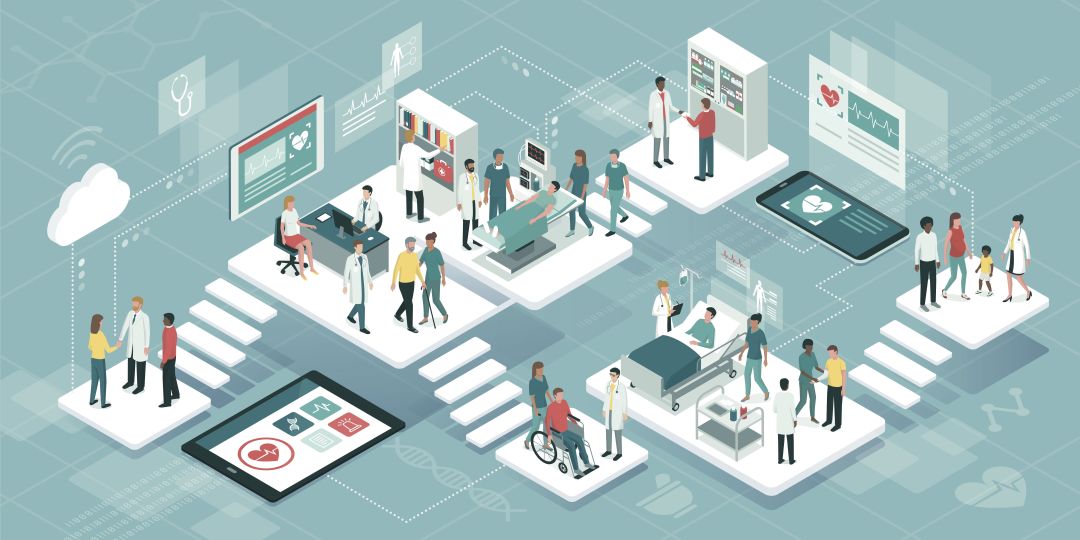The Future of Health Care in Oregon Is Virtual

Across Oregon, telehealth services by Oregon Health & Science University, Providence, and Legacy have been around for years. But as COVID-19 continues to devastate the US, with many states now seeing an increase in cases, demand for such services has skyrocketed.
Image: elenabasl/Shutterstock
As with just about every other facet of daily life, a visit with the doctor looks and feels a little different during a pandemic.
“They set [the virtual visit] up and they send it to my phone. Then I had to wait for the doctor! I could hear his kids in the background. That was the only difference,” says North Portlander Don Nelson. “Well, and I guess he didn’t stick a finger up there to feel my prostate.”
For years, virtual care—which comprises of various remote-healthcare technologies and services including telehealth apps and virtual visits via smart phone, tablets, or computers—has played a fairly minor role in the US’s trillion-dollar healthcare industry. Prior to the coronavirus outbreak, telehealth in the US accounted for about $3 billion nationwide, according to a May report by McKinsey & Company. From 2019 to 2020, US consumers using telehealth increased from 11 percent to 46 percent, and providers on average are seeing more than 50 times the number of patients via telehealth than they did before.
As consumers and providers continue to adopt telehealth services amid the coronavirus pandemic, the same reports estimates “up to $250 billion of current US healthcare spend could potentially be virtualized.” Across Oregon, telehealth services by Oregon Health & Science University, Providence, and Legacy have been around for years. But as COVID-19 continues to devastate the US, with many states now seeing an increase in cases, demand for such services has skyrocketed. According to Oregon Business, OCHIN, which works with more than 15,000 providers, including the Multnomah County Health Department, in 48 states, says 75 percent of its membership transitioned to providing telehealth services amid the coronavirus pandemic.
Before March, the Oregon Clinic had not offered any telehealth services or visits. The Oregon Clinic CEO Thomas Sanchez says the physician-led specialty medical group offered telephone consultations for things like prescription refills, “but it wasn’t about diagnosing patients. So when the stay-at-home orders [in Oregon] started to come and elective procedures started to get canceled, that was a really significant shift.”
That shift meant converting their business communication platform (Microsoft Teams) into a virtual visit platform so the Oregon Clinic could connect with its patients, and on March 25, it officially began offering virtual visits. Sanchez says the Oregon Clinic was seeing about 500 patients a day virtually throughout April, which equated to about 50 percent of its total visits. That number rounds out to about 200-350 patients a day now that elective procedures in Oregon started back up in May, but with a rising number of coronavirus cases and physical distancing measures still in place, Sanchez says he’s encouraging patients and providers to continue to use virtual visit platforms.
“If there’s any silver lining in this, it’s absolutely telehealth,” Sanchez says.
When the Trump administration passed the Coronavirus Preparedness and Response Supplemental Appropriations Act, it waived Oregon’s parameters that required patients, even in rural areas, to conduct a telehealth visit from a healthcare facility. Now, patients can call in from their homes using any kind of video technology such as Teams or Facetime. In addition, insurance companies have started implementing payment parities which allows patients to pay for telehealth services as they would a normal walk-in doctor’s visit. A new coalition of independent medical clinics is hoping to make that permanent, pointing to states like Washington and Colorado, which recently passed legislation to provide payment parity for telehealth.
“We believe Oregon should do the same and expect that during the 2021 legislative session that it will be a topic and it will be considered during that time,” Sanchez says. “Both at the state level and at the federal level, there’s work that has to happen.”
The sudden surge in telehealth has highlighted the benefits of these services during a pandemic—particularly in rural or remote communities with limited availability to healthcare clinics, and for patients who are at high-risk for contracting COVID-19. Post-pandemic, these services could prove even more fruitful.
“For those patients that live in more rural parts of the state or parts of Washington, for them not to have to travel has been wonderful, and they’re telling us about it and how much they appreciate it and have asked that we continue to do it long term,” Sanchez says.
This shift into a digital health world, of course, comes with some caveats. Varying legislation from state to state and no federal guidelines on telehealth is one, but perhaps the most important is public access to the internet. In this day and age, internet access seems almost ubiquitous, but according to a 2019 Pew poll, 10% of US adults do not use the internet or are unable to access the internet. Of the people not online, the poll indicated they are mostly Black, Hispanic, 65 and older, make less than $30,000 a year, and live in predominantly rural areas.
“That’s why we can’t just pivot and force patients to do telehealth,” says Dick Clark, CEO of the Portland Clinic. “We don’t want to make telehealth just a service for the middle class and above. We want to make sure it’s accessible to everyone.”
The Portland Clinic also did not offer any telehealth services prior to February simply due to lack of demand among its patients. When coronavirus hit, the Portland Clinic created its telehealth program in seven days, and in April, it curtailed its in-person visits. Telehealth visits went up by more than 12,000 that month. Now in July, Clark says about 20 percent of patient visits are through telehealth. The medical industry, Clark says, has much to consider as it moves forward and utilizes telehealth during and after the pandemic, such making payment parity permanent and navigating when to see a patient in-person or through virtual services.
“As a medical industry, what we need to consider is what are the appropriate uses for telehealth, and when should a patient be seen in person. And we shouldn’t become overly dependent on telehealth because medicine is still a practice of touch, and so much can be learned by seeing a patient face to face.”
At OHSU, digital health visits completed during February totaled around 1,100. In March, that figure jumped up to 13,000. In addition, call logs to its online patient portal MyHealth surged from 300 in February to more than 10,000 in April.
Not only is OHSU seeing more virtual visits, it is also establishing a remote emergency response critical care network. As part of a US Army-funded “proof of concept” project, OHSU is expanding its virtual intensive care unit platform to establish the new network, which could be useful if the Oregon experiences a second coronavirus wave or a natural disaster in the future.
Dr. David Zonies, associate chief medical officer for critical care services at OHSU, says the network was an “aspirational idea” in the event that local healthcare resources are not available, a natural disaster, such as Hurricane Katrina, overwhelms those resources, or—from a military perspective—a soldier is injured and can’t be evacuated because they are under fire or resources are limited. When COVID-19 came around, Zonies says it accelerated the idea.
The system would work like a massive communication device from experts at OHSU to rural hospitals or temporary headquarters, such as armories or tents, enabling audio-visual capabilities and remote monitoring of things like blood pressure and oxygen flow.
Although still inactive and currently undergoing more work, Zonies says in the event of an increase in coronavirus cases in the state, the network could be ready, at least regionally, in about two weeks. Zonies sees the implementation of this technology as a way forward into a broader digital era of health, reshaping the ways in which doctors and clinicians practice and operate.
“It’s traditionally been the situation where we felt we had to physically be present in order to provide clinical care, and in some cases we do. But in other areas … we’re now able to leverage this technology, especially in COVID when we have to do some physical distancing,” Zonies says. “It’s a culture change, no doubt. But I think it’s an important change.”




